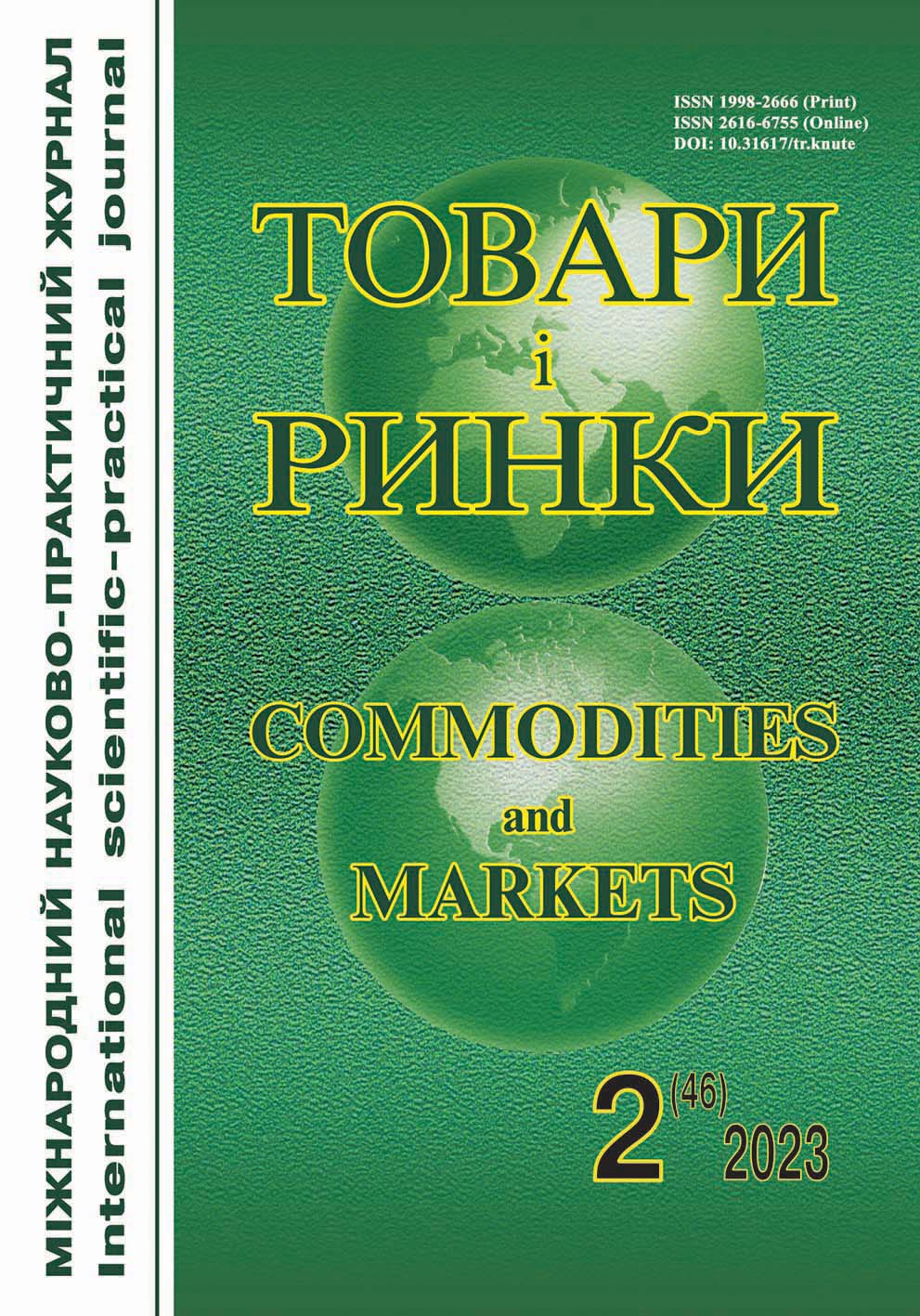Categorization of chocolate
DOI:
https://doi.org/10.31617/2.2023(46)06Keywords:
chocolate, forming of the product category, retail trade, segmentation, consumer preferences.Abstract
Introduction. The confectionery market in Ukraine is well-established and highly competitive. There is a significant number of companies that for a long time produce, supply and sell a fairly wide assortment of products, which, taking into account the needs and requests of consumers, constantly undergoes market transformations.
Problem. Taking into account the consumers opinion in the formation of the goods assortment is one of the numerous factors of ensuring the profitability of enterprises. Therefore, identifying the opinions of consumers regarding the formation of a product category of chocolate, developing an assortment matrix to meet the needs of the target audience is expedient and does not lose its relevance.
The aim of the research is to identify the consumer preferences of chocolate through the establishment and ranking the importance of consumer needs, determining the motivation to purchase it while forming a product category
Methods. The methods of internet survey, analysis, synthesis and forecasting were used.
Segmentation, as a process of dividing the target audience into groups, is carried out according to the following characteristics: gender, age, marital status, education, frequency of chocolate products consumption, location of the trade company, etc. The distribution of the target audience of chocolate consumers was based on geographic, demographic, psychographic, socio-economic and behavioral principles.
Results. While analyzing and summarizing the obtained results, the main directions for improving the assortment and consumption properties of chocolate were determined, in particular, the introduction of lactose-free milk chocolate, vegetable milk chocolate, vegan chocolate, and the increase of the share of nuts in the ingredient composition of chocolate.
The results of the study confirm that consumer surveys are a fairly effective means of communication, which positively affects the performance of production and trade enterprises. Thanking to the use of open questions in the survey and the analysis of the answers, it is possible to establish the significance of the problem, consumer awareness about the tasks to be solved.
Conclusions. The most important principle of marketing is consumer orientation, which is ensured by a number of measures, important among which are market segmentation and the formation of an assortment matrix.
By identifying the demand on chocolate through an Internet survey, it was established how the systematic activity of production and trading enterprises contributes to the improvement of the assortment, affects the motivation of consumers to purchase chocolate.
References
Kil'nic'ka, O. S., Kravchuk, N. I., & Kucmus, N. M. (2018). Confectionery market in Ukraine: trends and development prospects. Economy of agro-industrial complex, 11, 29-43 [in Ukrainian].
Tychyns'ka, A. I., & Naumova, M. A. (2017). Research of the confectionery market of Ukraine. Bulletin of SSS. (Issue 9), (pp. 122-126). https://jvestnik-sss.donnu.edu.ua/article/view/4859 [in Ukrainian].
Tkachenko, A., Syrokhman, I., Lozova, T., Ofilenko, N., Goryachova, E., Hmelnitska, Y., & Shurduk, I. (2019). Development of formulations for spongecakes made from organicraw materials using the princip lesof a food products safety management system. Eastern-European Journal of Enterprise Technologies, 1 (11 (97), 60-70. https://doi.org/10.15587/1729-4061.2019.155775 [in English].
Kyrychenko, S. O., & Polovynka, K. I. (2021). Principles of assortment policy formation. Agrosvit, 1-2, 90-94. https://doi.org/10.32702/2306-6792.2021.1-2.90 [in Ukrainian].
Fedorjak, R. M., & Andrijchuk, A. O. (2014). Problematic issues of the formation of assortment policy of trade enterprises. Technologies and design. https://er.knutd.edu.ua/bitstream/123456789/1056/1/td_2014_N4_11.pdf [in Ukrainian].
Abramovych, I. A. (2017). The product range of the enterprise: essence and conditions of formation. Scientific Bulletin of the Uzhhorod National University, 12, 6-9. http://www.visnyk-econom.uzhnu.uz.ua/archive/12_1_2017ua/3.pdf [in Ukrainian].
Jefimova, Je. O. (2017). The relevance of assortment policy in the modern management of a retail enterprise. International electronic scientific journal "Trajectories of Science", 7 (12), 3.1-3.14. http://www.pathofscience.org [in Ukrainian].
Zerbini, C., Vergura, D. T., & Luceri, B. (2019). How fair-trade claims and emotional empathy affect the consumer’s propensity to buy fair chocolate? British Food Journal. Vol. 121, 7, 1605-1613. https://doi.org/10.1108/BFJ-07-2018-0417 [in English].
Del Prete, M., & Samoggia, A. (2020). Chocolate consumption and purchasing behaviour review: Research issues and insights for future research. Sustainability. (Vol. 12 (14), (5586). https://doi.org/10.3390/su12145586 [in English].
Gabrielli, V., & Baghi, I. (2016). Online Brand Community within the Integrated Marketing Communication System: When Chocolate Becomes Seductive like a Person. J. Mark. Commun. (Vol. 22), (pp. 385-402) https://www.tandfonline.com/doi/abs/10.1080/13527266.2014.894932?journalCode=rjmc20 [in English].
Merlino, V. M., Mota-Gutierrez, J., Borra, D., Brun, F., Cocolin, L., Blanc, S., & Massaglia, S. (2021). Chocolate Culture: Preferences, Emotional Implications and Awareness of Italian Consumers. Int. J. Gastron. Food Sci. (Vol. 25). (Art. 100374). https://doi.org/10.1016/j.ijgfs.2021.100374 [in English].
Chocolate. Survey of consumers. 2023. https://docs.google.com/forms/d/e/1FAIpQLSf5yDPEBR__dUhXuSpYWs6Ip1041bzZ-O1PVVZs70sXm9G92Q/closedform [in Ukrainian].
Chocolate. General specifications. (2015). DSTU 3924:2014. Kyiv: Derzhspozhyvstandard of Ukraine [in Ukrainian].
Requirements for cocoa and chocolate products: Order of the Ministry of Agrarian Policy and Food of Ukraine № 157. Valid from 13.04.2016. https://zakon.rada.gov.ua/laws/show/z0688-16#n13 [in Ukrainian].
Is chocolate useful and how to choose the right sweets: advice from the Ministry of Health. https://tsn.ua/ukrayina/chi-korisniy-shokolad-ta-yak-pravilno-obrati-solodoschi-poradi-moz-1820428.html [in Ukrainian].
The country that consumes the most chocolate has been determined. https://vesti.dp.ua/viznacheno-krayinu-yaka-spozhivaye-najbilshe-shokoladu [in Ukrainian].
Trends in the world market of chocolate products. https://export.gov.ua/industry/review/26 [in Ukrainian].
Analysis of the confectionery products market in Ukraine. (2021). About consulting. https://pro-consulting.ua/ua/issledovanie-rynka/analiz-rynka-konditerskih-izdelij-v-ukraine-2021-god [in Ukrainian].
Ves'olov, В. What is market segmentation and what is its role in marketing. https://sendpulse.ua/blog/what-is-market-segmentation [in Ukrainian].
Assortment matrix. https://avtovsamare.ru/uk/assortimentnaya-matrica-primer-v-excel-enciklopediya-marketinga [in Ukrainian].
What is ruby chocolate? https://swissmade.direct/uk/83 [in Ukrainian].




